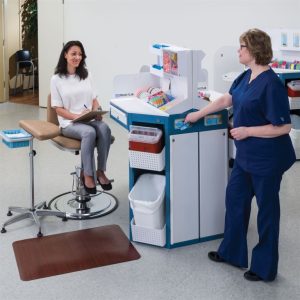What Is a Certified Medical Assistant? Essential Facts & Career Insights
A practical guide to understanding the role of a certified medical assistant (CMA), how certification works, career paths, daily duties, and tips to thrive in this dynamic healthcare support field.
Introduction: The CMA at a Glance
Certified Medical assistants (CMAs) are skilled healthcare professionals who bridge clinical care and office administration in busy medical settings. They perform a blend of patient-centered clinical tasks and essential administrative duties to keep clinics, doctors’ offices, and outpatient centers running smoothly. The CMA credential, awarded by a recognized certifying body, signals to employers that you have completed formal training and passed a national exam. If you’re curious about what a CMA does, how to become one, or what the career prospects look like, you’ve landed in the right place. Below, you’ll find practical, up-to-date facts to guide your decision and your next steps.
What Is a Certified Medical Assistant (CMA)?
A Certified Medical Assistant (CMA) is a healthcare professional trained to support both clinical and administrative tasks in medical settings. The CMA credential is awarded by the American Association of Medical Assistants (AAMA) after completion of an accredited training program and triumphant passage of the CMA exam. CMAs are prepared to do a wide range of work, including taking patient histories, preparing patients for examinations, assisting wiht procedures, performing basic lab tasks, measuring vital signs, and handling front-office duties such as scheduling and medical record management.
Key points to know about the CMA role:
- CMAs are trained to assist in clinical duties and to manage administrative tasks that keep a practice efficient.
- the CMA credential demonstrates a commitment to professional standards and ongoing education.
- CMAs work under the supervision of physicians, nurse practitioners, or physician assistants, depending on state laws and practice settings.
How to Become a Certified Medical Assistant
Becoming a CMA typically involves three core steps: completing an accredited medical assisting program, meeting eligibility requirements for the CMA exam, and passing the national CMA exam. Here’s a practical road map:
- Choose an accredited program – Look for a postsecondary medical assisting program accredited by CAAHEP (Commission on Accreditation of Allied Health Education Programs) or ABHES (Accreditation Bureau of Health Education Schools). Thes programs typically take about 9 to 12 months (certificate) or 12 to 24 months (associate degree).
- Prepare for the CMA exam - After program completion, apply for the CMA exam administered by the American Association of Medical Assistants (AAMA). Review the exam content areas and take advantage of study guides and practice tests.
- Pass the CMA exam and maintain certification – Upon passing, you earn the CMA credential. Maintaining the CMA requires ongoing continuing education (CE) and periodic recertification according to AAMA’s renewal policies.
Tip: If you’re weighing options, consider whether you prefer a shorter certificate program or a longer associate degree path. Both can lead to the CMA credential, but longer programs can provide deeper clinical exposure and more complete coursework.
Certification Options for Medical Assistants
Beyond the CMA credential (AAMA), several other national certifications recognize the medical assisting profession. Each has different focus areas,renewal requirements,and issuing bodies. Here is a concise comparison to help you decide which path fits your goals.
| Credential | Issuing Body | Primary Focus | Validity | Renewal |
|---|---|---|---|---|
| CMA (AAMA) | American Association of Medical Assistants | Clinical and administrative skills; comprehensive CMA exam | Indefinite until recertification? (Recertify every 60 months) | Continuing Education Units (CEUs) every 60 months; renewal fee |
| CCMA | National Healthcareer Association (NHA) | Clinical and administrative MA duties; flexible eligibility | 10 years (varies by policy; often lifetime if maintained with CEUs) | CEUs required for renewal; fees apply |
| RMA | American Medical Technologists | General medical assisting expertise; broad scope | Regular renewal required | CEUs; periodic renewal cycles |
Notes:
- The CMA (AAMA) is one of the most recognized and widely available certifications in the United States.
- Some states or employers may prefer specific certifications; check local job postings to tailor your path.
- Regardless of the credential,ongoing CEUs help you stay current with healthcare regulations and best practices.
Duties, Skills, and Daily Tasks
A CMA combines clinical competencies with administrative adeptness. Depending on the practice, your day may include a mix of patient care, chart management, and teamwork with healthcare professionals.
Clinical duties
- Measuring vital signs (blood pressure, pulse, temperature, respiration)
- Recording patient histories and preparing patients for exams
- Assisting with procedures and setting up sterile fields
- Collecting specimens for laboratory tests (urine, blood draws under supervision)
- Administering basic medications or injections as permitted by state laws
- Preparing and performing basic diagnostic tests (e.g., EKG)
Administrative duties
- Scheduling appointments and managing the calendar
- Medical document management, charting, and coding basics
- Billing, patient insurance verification, and claims processing
- Maintaining medical records and privacy compliance (HIPAA)
- Communicating with patients and coordinating care with other providers
Work Settings & Career Prospects
CMAs find opportunities across diverse healthcare environments.Common settings include:
- Primary care clinics and urgent care centers
- Specialty practices (pediatric, cardiology, dermatology, orthopedics, etc.)
- Hospitals and outpatient departments
- Home health agencies and long-term care facilities
- medical testing laboratories and diagnostic centers
Career growth for CMAs can include roles such as:
- Senior Medical Assistant or Lead MA
- Clinical Office Manager
- Privacy and compliance roles within practice management
- transition paths toward licensed practical/vocation nurse (LPN/LVN) or registered nursing programs
Location,experience,and the specific practice setting influence earning potential and advancement opportunities. Rural clinics, for example, may offer broader responsibilities and opportunities for rapid growth, while urban hospitals may provide broader specialization and continuing education resources.
Benefits, Practical Tips, and Professional Growth
Being a CMA offers meaningful benefits beyond daily patient care. Here are practical tips to maximize success and job satisfaction:
- Invest in quality training: Enroll in an accredited program, seek hands-on clinical experiences, and practice essential skills regularly.
- Stay organized: Develop strong charting, scheduling, and time-management routines to reduce stress and increase efficiency.
- Expand your skill set: Learn basic phlebotomy,injections,ECG,specimen handling,and electronic health record (EHR) systems.
- Prioritize patient communication: Build rapport, explain procedures clearly, and maintain patient privacy and comfort.
- Explore specialization: If you’re drawn to a field, consider targeted training (pediatrics, dermatology, cardiology) to differentiate yourself.
- plan for certification renewal: Track CEU requirements and renewal deadlines to avoid lapses.
Benefits of becoming a CMA include strong employment prospects, versatility across care settings, and a clear pathway to further healthcare education if you decide to advance toward nursing or other clinical roles.
Case Studies: Real-Life CMA Journeys
Case Study 1: Maria’s Path to CMA and Beyond
Maria started in a 12-month certified medical assisting program near her hometown. After graduation, she earned the CMA (AAMA) credential and joined a family practice clinic as a clinical assistant. Her daily duties include vitals, patient education, and assisting with routine immunizations. She used her CMA certification as a springboard to pursue a related certificate in phlebotomy, expanding her scope and earning potential.
Case Study 2: Ethan’s Rural Clinic Experience
Ethan works at a rural community clinic where the CMA role requires flexibility and broad coverage of tasks.he handles front-desk duties, patient intake, and basic lab work, while also helping with backlog management and telemedicine preparation. His proactive approach to multi-tasking and strong communication with the physician team helped the clinic improve patient throughput and satisfaction.
Salary, Job Outlook, and What Affects Pay
Salary for CMAs varies by location, experience, employer, and specialization. Factors that commonly influence pay include:
- Geographic region and local cost of living
- Type of employer (private practice vs. hospital vs.outpatient clinic)
- credential type and continuing education activity
- Experience level and demonstrated proficiency in clinical and administrative duties
Job prospects for CMAs are typically strong, with steady demand due to the ongoing need for skilled support in healthcare settings. Many healthcare facilities rely on cmas to improve patient flow, support clinicians, and maintain efficient administrative processes. The field also offers opportunities to advance into supervisory roles, specialized clinical tasks, or transition into nursing or allied health programs.
Quick Tips for Aspiring CMAs
- Choose an accredited program to ensure eligibility for the CMA exam.
- Budget for exam fees and renewal costs; keep CEU records organized.
- Practice patient interactions and clinical procedures through simulations or lab work.
- Explore internships or externships to gain real-world experience before graduation.
- Network with local medical offices to learn about vendor-specific EHRs and workflow practices.
Conclusion: Your Path to a rewarding CMA Career
A Certified Medical Assistant plays a pivotal role in the day-to-day functioning of healthcare teams. The CMA credential signals a commitment to professional competence, patient care, and continuous learning. Whether you’re drawn to clinical work, administrative efficiency, or a blend of both, becoming a CMA offers a versatile, in-demand career path with opportunities to advance, specialize, or pivot to nursing or other healthcare professions.
If you’re ready to start, research accredited programs, review CMA exam requirements with the AAMA, and map out a plan for ongoing education. With dedication and practical experience, you can build a satisfying career that makes a real difference in patients’ lives.



